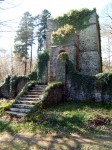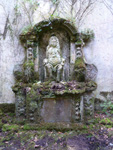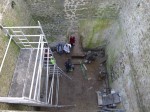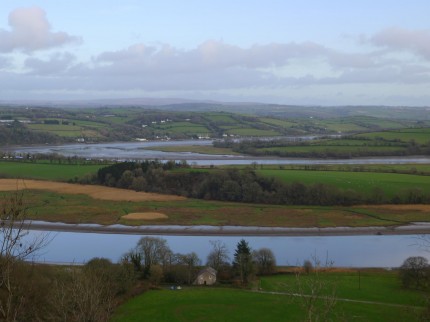 The archaeological investigation of Sir James Tillie’s mausoleum on the grounds of Pentillie Castle, the estate he built in Cornwall in 1698, has revealed the skeletal remains of a man in the vault underneath the current floor of the turret structure. Although there are no plans to remove the bones for laboratory analysis and DNA testing, the context strongly suggests these are the mortal remains of Sir James Tillie. As Ted Coryton, current owner of Pentillie Castle, says: “There is not really any doubt about who the remains belong to.”
The archaeological investigation of Sir James Tillie’s mausoleum on the grounds of Pentillie Castle, the estate he built in Cornwall in 1698, has revealed the skeletal remains of a man in the vault underneath the current floor of the turret structure. Although there are no plans to remove the bones for laboratory analysis and DNA testing, the context strongly suggests these are the mortal remains of Sir James Tillie. As Ted Coryton, current owner of Pentillie Castle, says: “There is not really any doubt about who the remains belong to.”
That’s because Sir James’ final wishes in regards to the disposition of his body were eccentric, to say the least, and the odds of anyone else getting buried in the folly of a private estate in the hundred or so years between his death and the modifications to the mausoleum are slim to none.
 Sir James Tillie was a self-made man who, as far as we can discern from the many lies he told about himself, went from Baronet Sir John Coryton’s land agent to knight to husband of Sir John’s widow and owner of the estate he once managed. (It was rumored that that last step was accomplished with the aid of poison.) His meteoric rise was accompanied with a very high self-opinion, so high, in fact, that he believed not even death could keep him down for long.
Sir James Tillie was a self-made man who, as far as we can discern from the many lies he told about himself, went from Baronet Sir John Coryton’s land agent to knight to husband of Sir John’s widow and owner of the estate he once managed. (It was rumored that that last step was accomplished with the aid of poison.) His meteoric rise was accompanied with a very high self-opinion, so high, in fact, that he believed not even death could keep him down for long.
He had a folly built on Mount Ararat, the highest hill on his estate with beautiful views of his mansion and the hairpin bend of the River Tamar. Instead of being interred in the tower, Sir James ordered that his body was to be dressed in his best clothes and bound to a large chair facing a window. He died on November 17th, 1713, and his servants fulfilled his wishes. There he would sit, next to his favorite books, a bottle of port and his pipe, until his resurrection which he was convinced would occur within two years of his death.
 For two years, his servants brought his decaying body food and drink, but when the expected resurrection event never happened, they decided they had to inter Sir James’ remains instead of letting him sit there, exposed to the elements, rotting until the bonds could no longer hold him to the chair. He was buried and a statue of Sir James in his chair was placed at the same window where his body has sat watch for two years.
For two years, his servants brought his decaying body food and drink, but when the expected resurrection event never happened, they decided they had to inter Sir James’ remains instead of letting him sit there, exposed to the elements, rotting until the bonds could no longer hold him to the chair. He was buried and a statue of Sir James in his chair was placed at the same window where his body has sat watch for two years.
No specific evidence of where the remains were buried has survived. He might have been buried in the parish church of St. Mellion, the traditional resting place of the Coryton family, or in another parish church. He might have been buried in the mausoleum. No headstone or documentation of his final resting place has ever been found.
 The estate remained in Tillie hands for three generations after Sir James’ death, and then returned through marriage to the Coryton family. They appear to have modified the mausoleum during an expansion of the estate in 1810. That was the last time it was maintained, and although the estate in general survived in decent condition until a neglectful shut-in owner let it go to pot in the late 20th century, the mausoleum did not. It was crumbling, structurally unsound, choked with ivy and weeds.
The estate remained in Tillie hands for three generations after Sir James’ death, and then returned through marriage to the Coryton family. They appear to have modified the mausoleum during an expansion of the estate in 1810. That was the last time it was maintained, and although the estate in general survived in decent condition until a neglectful shut-in owner let it go to pot in the late 20th century, the mausoleum did not. It was crumbling, structurally unsound, choked with ivy and weeds.
 When Ted Coryton and his wife inherited the property in 2007, they initiated an extensive program of restoration. Once the main house was in tip-top shape, they turned their attention to the gardens and to the mausoleum. With grants from Natural England and the Country Houses Foundation, last year the mausoleum was finally able to get some attention. The statue was sent to Cliveden Conservation in Bath for restoration while back at the folly conservators cleared the vegetation, did some long overdue mortar pointing and rebuilding of the walls, repaired cracks and rebuilt the tower crenellations.
When Ted Coryton and his wife inherited the property in 2007, they initiated an extensive program of restoration. Once the main house was in tip-top shape, they turned their attention to the gardens and to the mausoleum. With grants from Natural England and the Country Houses Foundation, last year the mausoleum was finally able to get some attention. The statue was sent to Cliveden Conservation in Bath for restoration while back at the folly conservators cleared the vegetation, did some long overdue mortar pointing and rebuilding of the walls, repaired cracks and rebuilt the tower crenellations.
In order to accomplish all the work that needed doing, they had to stabilize the floor so they could build scaffolding. In October of last year, builders dug an exploratory hole in the floor and found a brick vaulted roof underneath the granite slabs. This was probably a function of the addition built in the early 19th century which made the original first floor into the ground floor to accommodate a new plinth.
 Archaeologist Oliver Jessop explored the vaulted area and found that it was structurally sound, lined with plaster with the brick vaulted ceiling in excellent condition. He also found a human skeleton and the remains of a wooden object covered with leather and studs. It’s not clear exactly what this piece was, but its age and style suggest that it might be an early 18th century chair, perhaps the very one Sir James’ sat in awaiting his resurrection.
Archaeologist Oliver Jessop explored the vaulted area and found that it was structurally sound, lined with plaster with the brick vaulted ceiling in excellent condition. He also found a human skeleton and the remains of a wooden object covered with leather and studs. It’s not clear exactly what this piece was, but its age and style suggest that it might be an early 18th century chair, perhaps the very one Sir James’ sat in awaiting his resurrection.
 Pictures of the remains have not been released out of respect for what turned out to be Sir James’ final resting place despite his belief in his own immortality. The Coryton plans to publish more information about the mausoleum restoration. If you have a chance to visit Pentillie Castle in person, the estate is holding Garden Open Days in March, April and May. A member of the family will lead groups on tours through the grounds, including the newly restored kitchen garden which until recently was a mass of brambles, and share first-hand information about the restoration. The mausoleum won’t yet be available for tours at that point as work is ongoing, but visitors will get to hear all the juicy history they’ve uncovered thus far in the process.
Pictures of the remains have not been released out of respect for what turned out to be Sir James’ final resting place despite his belief in his own immortality. The Coryton plans to publish more information about the mausoleum restoration. If you have a chance to visit Pentillie Castle in person, the estate is holding Garden Open Days in March, April and May. A member of the family will lead groups on tours through the grounds, including the newly restored kitchen garden which until recently was a mass of brambles, and share first-hand information about the restoration. The mausoleum won’t yet be available for tours at that point as work is ongoing, but visitors will get to hear all the juicy history they’ve uncovered thus far in the process.

Creepy guy.
Imagine if he had been resurrencted – tied to chair and unable to reach his port and pipe!
I started reading, realized that I’d read about this before and then was like, “oh! It was here.”
well that’s a relief.